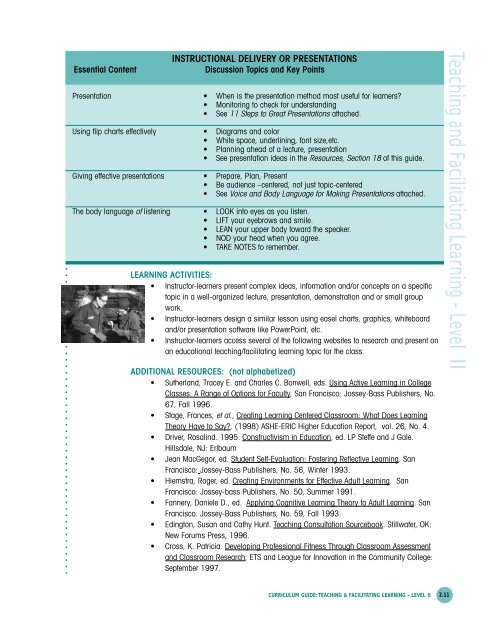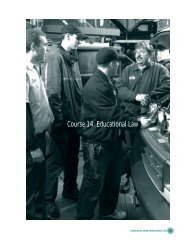Facilitating
Teaching and Facilitating Learning - Level 2 - Washington State ...
Teaching and Facilitating Learning - Level 2 - Washington State ...
- No tags were found...
Create successful ePaper yourself
Turn your PDF publications into a flip-book with our unique Google optimized e-Paper software.
○ ○ ○ ○ ○ ○ ○ ○ ○ ○ ○ ○ ○ ○ ○ ○ ○ ○ ○ ○ ○ ○ ○ ○ ○ ○ ○ ○ ○ ○ ○ ○ ○ ○ ○ ○ ○ ○ ○ ○ ○ ○ ○ ○ ○ ○ ○ ○INSTRUCTIONAL DELIVERY OR PRESENTATIONSEssential Content Discussion Topics and Key PointsTeaching and <strong>Facilitating</strong> Learning - Level IIPresentation • When is the presentation method most useful for learners?• Monitoring to check for understanding• See 11 Steps to Great Presentations attached.Using flip charts effectively • Diagrams and color• White space, underlining, font size,etc.• Planning ahead of a lecture, presentation• See presentation ideas in the Resources, Section 18 of this guide.Giving effective presentations • Prepare, Plan, Present• Be audience –centered, not just topic-centered• See Voice and Body Language for Making Presentations attached.The body language of listening • LOOK into eyes as you listen.• LIFT your eyebrows and smile.• LEAN your upper body toward the speaker.• NOD your head when you agree.• TAKE NOTES to remember.LEARNING ACTIVITIES:• Instructor-learners present complex ideas, information and/or concepts on a specifictopic in a well-organized lecture, presentation, demonstration and or small groupwork.• Instructor-learners design a similar lesson using easel charts, graphics, whiteboardand/or presentation software like PowerPoint, etc.• Instructor-learners access several of the following websites to research and present onan educational teaching/facilitating learning topic for the class.ADDITIONAL RESOURCES: (not alphabetized)• Sutherland, Tracey E. and Charles C. Bonwell, eds. Using Active Learning in CollegeClasses: A Range of Options for Faculty, San Francisco: Jossey-Bass Publishers, No.67, Fall 1996.• Stage, Frances, et al., Creating Learning Centered Classroom: What Does LearningTheory Have to Say?, (1998) ASHE-ERIC Higher Education Report, vol. 26, No. 4.• Driver, Rosalind. 1995. Constructivism in Education, ed. LP Steffe and J Gale.Hillsdale, NJ: Erlbaum• Jean MacGegor, ed. Student Self-Evaluation: Fostering Reflective Learning. SanFrancisco: Jossey-Bass Publishers, No. 56, Winter 1993.• Hiemstra, Roger, ed. Creating Environments for Effective Adult Learning. SanFrancisco: Jossey-bass Publishers, No. 50, Summer 1991.• Fannery, Daniele D., ed. Applying Cognitive Learning Theory to Adult Learning. SanFrancisco: Jossey-Bass Publishers, No. 59, Fall 1993.• Edington, Susan and Cathy Hunt. Teaching Consultation Sourcebook. Stillwater, OK:New Forums Press, 1996.• Cross, K. Patricia. Developing Professional Fitness Through Classroom Assessmentand Classroom Research, ETS and League for Innovation in the Community College:September 1997.CURRICULUM GUIDE: TEACHING & FACILITATING LEARNING - LEVEL II 2.11




